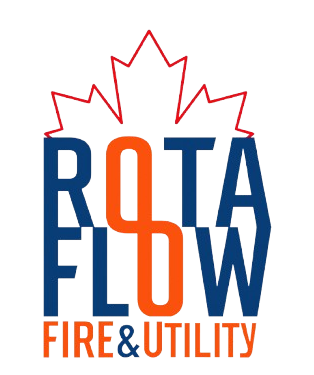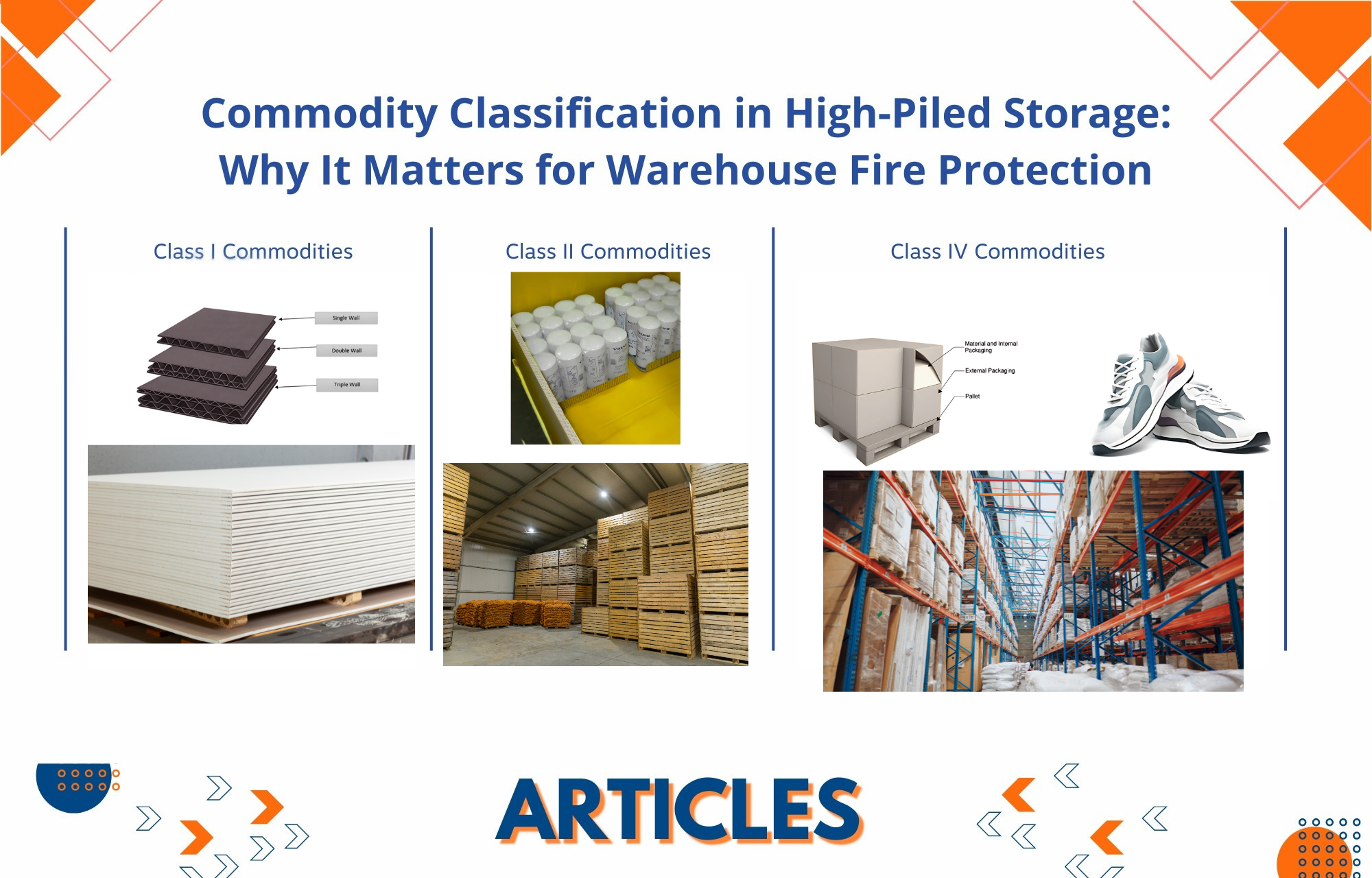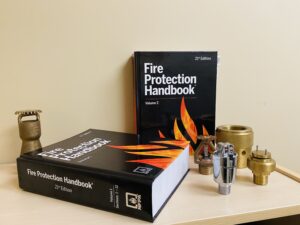Class I Commodities
Introduction
The way we keep commodities has shifted considerably in the modern economy. With the rapid growth of e-commerce and consumer expectations for same-day or next-day delivery, warehouses have emerged as the backbone of supply chains in cities, suburbs, and rural areas. To fulfil this demand, businesses are increasingly turning to high-piled storage facilities, which allow them to utilise space and store products at larger heights. While this approach increases productivity, it also poses severe fire safety challenges.
High-piled storage is more than just stacking items; it also has severe fire code standards to assure the safety of people, property, and firefighters. One of the most critical aspects of warehouse fire protection is commodity classification. How a product is classed under NFPA 13, NFPA 1, and the International Fire Code (IFC) dictates the level of fire protection and sprinkler design required. The classification system takes into account not only the product itself, but also the packaging and pallets. Even minor adjustments, such as converting from wood to plastic pallets, might elevate a commodity to a higher hazard category.
This blog explores why commodity classification is so important in high-density storage environments, how commodities are classified, and what these implications are for fire protection design and safety.
The Importance of Commodity Classification for High-Pile Storage Occupancies
Many of us have experienced and learnt to appreciate the opportunity to order something online and have it delivered the next day, or even the same day. In today’s economy, firms must keep items and supplies so that they can be easily accessed for shipping purposes. As a result, the demand for material storage in urban, suburban, and rural areas is expected to rise further. The number of warehouses being built in various jurisdictions is increasing. High-piled storage is a common use for these facilities.
In order to identify and classify commodities in storage facilities and ascertain the requisite fire protection requirements, Chapter 20 of NFPA 13, Chapter 34 of NFPA 1 (which makes reference to NFPA 13), and Chapter 32 of the International Fire Code (IFC) all use commodity classifications.
According to data from the National Fire Incident Reporting System (NFIRS), thousands of warehouse fires have occurred since 2014. Only 87% of the thousands of reported fires were put out with four or less fire sprinkler systems. Compare that figure to all other occupancies, where 96% of fires were extinguished by four or less sprinklers. The research indicates that flames in high-piled storage warehouses are difficult to suppress. It also emphasises the need of ensuring that the fire sprinkler system is properly constructed for what is stored in the facility.
What is the definition of high-piled combustible storage?
“Storage of combustible materials in closely packed piles or combustible materials on pallets, racks, or shelves where the top of storage is greater than 12 feet in height” is the definition of high-piled storage given by the IFC and NFPA 13. In addition, the IFC adds that “Where required by the fire code official, high-piled combustible storage also includes certain high-hazard commodities…where the top of storage is greater than 6 feet in height” . Because it also refers to noncombustible materials, the term “combustible” in high-piled combustible storage might be misleading. In other words, a product’s noncombustibility does not preclude its storage arrangement from satisfying the high-piled storage requirements of codes and standards.
The same requirements are outlined in NFPA 13 for Class I–IV commodities. It is important to remember, though, that Group A plastics (IFC: high hazard commodities) are subject to NFPA 13’s storage rule when stored at a height more than five feet. The IFC requires adherence to Section 3203.9 and restricts the quantity of Group A polymers used in Class I–IV commodity storage solutions. It is important to note that NFPA 1 and NFPA 13 use the same definitions for commodity classification.
The most crucial stage in calculating the proper fire protection requirements based on the IFC, NFPA 1, and NFPA 13 is to accurately determine the commodity categorisation. We know from experience that wrongly classifying commodities as lower hazards or altering the commodity to a higher hazard than the facility was built for can have disastrous repercussions. For this reason, it is critical for the qualified design expert to assess the commodity classification and collaborate closely with the body with jurisdiction to verify that the system deployed is appropriate. It is also critical for the fire code official to guarantee that what is installed is correctly maintained over time, and that commodities are not changed to a higher hazard without first being reviewed by a qualified design professional.
Keeping that in mind, let’s look at how the IFC and NFPA classified certain commodities.
Class I Commodities
NFPA 13, the International Fire Code, and the IFC state that “Class I commodities are noncombustible products in ordinary corrugated cartons with or without single thickness dividers, or in ordinary paper wrappings with or without wood pallets” . The definitions in NFPA 1 and NFPA 13 are nearly equivalent to the IFC standard. It is vital to remember that commodity classification considers (1) the product, (2) the packaging, and (3) the pallets used to store the product.

Noncombustible products are commonly packaged with foam, expanded plastics, or other combustible materials to safeguard them during storage and shipping. IFC Chapter 32 defines Class I commodities as uncartoned stoves and refrigerators, gypsum, water-based paints, and liquids in glass bottles or jars.

Example of a Class I commodity (gypsum)
Remember that just because a product is noncombustible does not mean it is immune from the fire safety requirements that apply to high-piled storage facilities.
Source: Swanson, J. (2024, October 18). The importance of commodity Classification for High-Piled Storage Occupancies – National Fire sprinkler. National Fire Sprinkler Association. https://nfsa.org/2024/10/18/commodity-classification-for-high-piled-storage/
Class II Commodities
Class II commodities are defined by the IFC, NFPA 1, and NFPA 13 as noncombustible goods packaged in solid wooden boxes, multiple-thickness paperboard cartons, slatted hardwood crates, or other combustible packing materials, either with or without wood pallets. The phrase makes it clear that the packaging and storage of goods matter just as much as the actual product.

Example of Class II Commodity
Class III Commodities
According to the IFC, NFPA 1, and NFPA 13, Class III commodities include goods made of wood, paper, natural fibre fabric, or Group C polymers, with or without wood pallets. According to NFPA 13, Class III commodities are made of wood, paper, natural fibres, or Group C plastics, and may or may not include cartons, boxes, or crates, as well as pallets. Class III commodities may contain a maximum of 5% by volume of expanded plastic from Group A or Group B plastics.

Example of Class III Commodity
Class IV Commodities
The IFC defines Class IV commodities as Class I, II, or III items including Group A plastics in regular corrugated boxes; Class I, II, and III products with Group A plastic packaging; Group B plastics; and free-flowing Group A plastics with or without wood pallets. Section 3203.9 specifies the maximum amount of non-free-flowing Group A polymers that may be used.
NFPA 1 and NFPA 13 go much further than the IFC, identifying seven conditions that comprise the Class IV commodity classification. The specifics depend on the amount of A or B plastics in the product being stored.

Example of Class IV Commodity
High-Hazard Commodities: Group A Plastics
The IFC defines high-hazard commodities as those that provide a higher fire risk than materials classed as Class I – IV. High-hazard commodities are those that pose unique fire threats in addition to those found in Class I through IV products. Group A plastics are classified as high-hazard. The IFC and NFPA 13 classify plastics as Group A, B, or C depending on their heat of combustion, with Group A indicating the highest hazard, followed by Group B plastics and finally Group C plastics. IFC Section 3203.4 states that Group C plastics should be classified as a Class III commodity. IFC Section 3203.5 states that Group B plastics should be classified as a Class IV commodity. Both the IFC and NFPA 13 require Group A plastics to meet the most demanding fire safety criteria due to their high heat release rate.

Example of an IFC High Hazard/NFPA 13 Rubber Tire commodity
NFPA 13 does not utilise the term “high-hazard commodity” as the IFC does. Rubber tires, for example, are classified as a separate commodity and are handled in Section 20.4.9. NFPA 13 contains a detailed list of plastics designated as Group A. The Group A plastics must then be separated into expanded and nonexpanded groups.
The following shows fire severity from highest to lowest across all commodity classifications.
(Highest Fire Severity)
⬇️
Exposed Expanded Plastics (Hugh hazard/Group A)
⬇️
Exposed Noneexpanded Plastics (Hugh hazard/Group A)
⬇️
Cartoned Expanded Plastics (Hugh hazard/ Group A)
⬇️
Cartoned Noneexpanded Plastics (High hazard/ Group A)
⬇️
Class IV
⬇️
Class III
⬇️
Class I
⬇️
(Lowest Fire Severity)
It is vital to remember that the IFC, NFPA 1, and NFPA 13 decide commodity classification based on the product, packaging, and pallet type (wood vs. plastic). All three must be considered when determining the commodity classification based on the IFC and NFPA 13.

Several high-profile fires have occurred at high-piled storage facilities in recent years. It’s no surprise that there are several fire prevention difficulties connected with high-piled storage warehouses, including, but not limited to, changes in commodity classification, owner-made adjustments to storage arrangements, and increasing or reducing storage height. Not to mention the difficulties involved with firefighting operations and how to attack heavy fuel load fires while ensuring firefighter safety. Even seemingly modest changes in the commodity or storage arrangement, such as switching from glass to plastic containers, can have a big impact on how a fire behaves and spreads.
Source: Swanson, J. (2025, July 1). The importance of commodity Classification for High-Piled Storage Occupancies – Class IV Commodities -. National Fire Sprinkler Association. https://nfsa.org/2025/07/01/high-piled-storage-occupancies/
Group B and C Plastics and Other Special Commodities
Section 20.4 of NFPA 13 provides various instances of plastics classified as Group A, B, or C. It also specifies the needs and particular protection criteria for rubber tire storage, rolled paper, baled cotton, plastic motor vehicle components and carton record storage.
Mixed Commodities
When multiple commodities are stored together, the IFC and NFPA 13 mandate that the fire sprinkler design be based on the highest hazard commodity present. This guideline prevents a system from being underdesigned when lower-hazard items are combined with higher-hazard ones.
IFC: There are other cases where a product is not mentioned in the code/standards tables but contains certain Group A plastics in its components or packaging. IFC uses Figures 3203.9(1) and (2) to classify commodities depending on the percentage of Group A polymers present.
NFPA 13: When Class III commodities include both expanded and nonexpanded Group A polymers, utilise Figure 20.4.3.3(a) for cartoned or crated storage and Figure 20.4.3.3(b) for exposed storage.
These figures serve as ratio charts, demonstrating when a little amount of Group A plastic can remain in a lower class and when it propels the entire commodity into Class IV or high hazard/Group A Nonexpanded or Expanded class.
Why It Matters
In practice, the most typical mistakes in commodity classification occur from the beginning. It is common to believe that a “noncombustible” product means there is no fire risk, however the packaging and pallets used can easily elevate the substance to a higher hazard class. A metal appliance coated in foam or a stack of glass bottles on plastic pallets are basic examples of how packaging and support materials affect fire safety requirements. If a result, both owners and fire officials must remember that the product, packing, and pallet are all important—and that classifications might fluctuate over time if shipping patterns or suppliers change. Keeping this in mind ensures that the system implemented is properly matched to the hazard and remains effective for the life of the structure.
The commodity categorisation must be accurately determined in order to apply the appropriate fire prevention standards and sprinkler design. Assigning a classification without fully considering the product, packing, and pallet can have disastrous effects for property protection, firefighter safety, and, ultimately, life.
Summary
As warehouses grow in size and complexity, the significance of correct commodity classification becomes increasingly apparent. A fire prevention system constructed for the improper hazard level can quickly become ineffective, endangering people, property, and entire businesses. The data speaks for itself: warehouse fires are more difficult to manage than in most other settings, and misclassification exacerbates the problem.
The main point is that commodity classification is not a one-time activity. It necessitates thorough review by competent fire protection professionals during the design phase, consultation with local code inspectors during installation, and continued monitoring as storage techniques evolve. Simply putting Group A plastics into packaging or altering pallet types can significantly increase fire hazards.
Recognising that the product, its packaging, and the storage method all important, facility owners, managers, and fire code inspectors may ensure that fire sprinkler systems and other protective measures remain effective in the long run.
In short, commodity categorisation is more than just a code requirement; it is a critical component of fire safety in high-piled storage facilities, protecting lives, lowering hazards for firefighters, and ensuring business continuity in today’s demanding logistics environment.
courtesy: Jon



